Traditional Figgy Pudding (Christmas Pudding)
This post may contain affiliate links. See my disclosure policy.
A thoroughly authentic Figgy Pudding recipe, also known as Christmas Pudding and Plum Pudding! It’s the perfect make-ahead dessert as the flavors only get better over time. A household favorite for centuries, no traditional Christmas is complete without a Figgy Pudding!
Serve this Christmas Pudding with my homemade Vanilla Custard or Hard Sauce and for another traditional English steamed pudding be sure to also try our Spotted Dick!
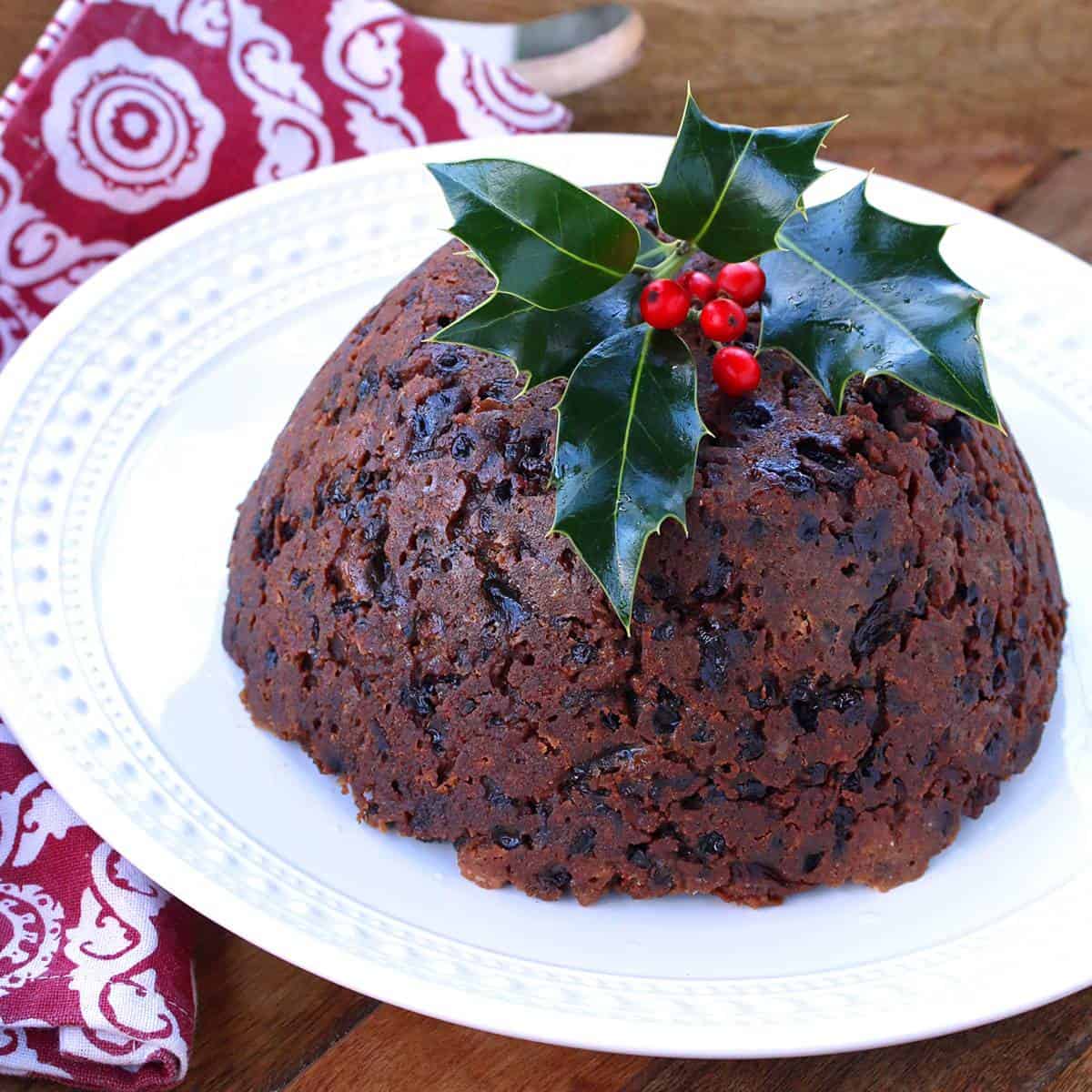
What is Figgy Pudding?
If you’re familiar with the figgy pudding Christmas carol, We Wish You a Merry Christmas, you may have asked yourself at some point, “what is a figgy pudding anyway?”
All three of these names refer to a traditional English steamed cake-like dessert comprised of breadcrumbs, flour, suet, sugar, eggs, brandy, lemon zest, candied citrus peel, spices, and dried fruits (specifically raisins, currants, and golden raisins). With respect to the different names, the short answer is that figgy pudding can be considered a much earlier precursor of plum pudding and they’ve both come to be referred to as Christmas pudding.
Ingredients (hint: no figs or plums)
Figgy pudding dates back to the 14th century and was a much different dish than what we refer to as figgy pudding today. It was more of a wet, sticky, thick porridge consisting of boiled figs, water, wine, ground almonds, raisins and honey. It later evolved into incorporating ground meat and grains and then later still evolved into a steamed pudding that was made with raisins.
Where does the term “plum” pudding come from? Plums were what the pre-Victorians called raisins, and dried fruits in general, and the name stuck. It wasn’t until 1845 when it first came to be called “Christmas Pudding” in Eliza Acton’s bestselling cookbook, Modern Cookery for Private Families.
And so we have three names that are still used in different regions of the English-speaking world. In the U.S. it is more commonly called Figgy Pudding whereas in the UK and Ireland it is more commonly known as Christmas Pudding (or simply “pud”), or Plum Pudding.
As with many traditional Christmas desserts, plum pudding incorporates symbolism reflective of Christ such as the holly (representing the crown of thorns), and setting the pudding on fire (representing the passion of Christ).
Can I Omit the Alcohol?
The brandy serves as a preservative for prolonging the shelf life of the pudding and also draws out more flavor from the ingredients as the pudding matures. You can omit the brandy if you prefer but the pudding will need to be stored in the fridge (wrapped extremely well to prevent drying out) and consumed within a week.
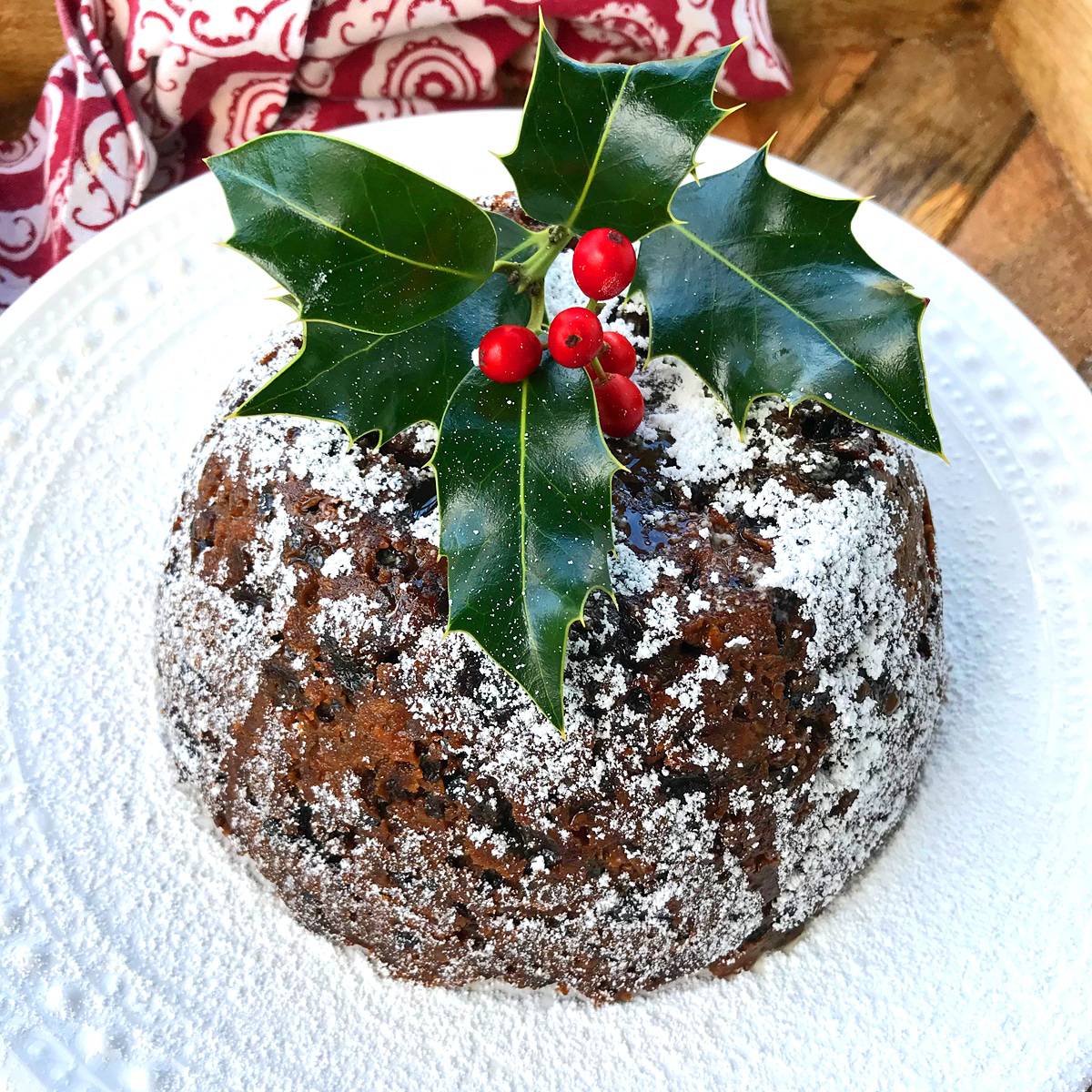
How Long Should You Steam Figgy Pudding?
You’ll see different recipes recommending different times – anything from 3 hours to 8 hours. There’s really no right or wrong to this but if you are using suet, which is traditional and what we recommend for the best texture, you’ll need to steam it for at least 4 hours, preferably longer as it takes suet a long time to break down (longer than butter) and to create the air pockets that gives desserts like this their characteristically soft texture.
The longer you steam the pudding the darker it will become, more closely resembling the pictures of traditional plum pudding you’ve seen. If you want that traditional dark brown color, steam it for closer to 8 hours.
It is very difficult to over-steam a pudding so if you’re uncertain, just keep steaming until your pudding is a rich, dark color.
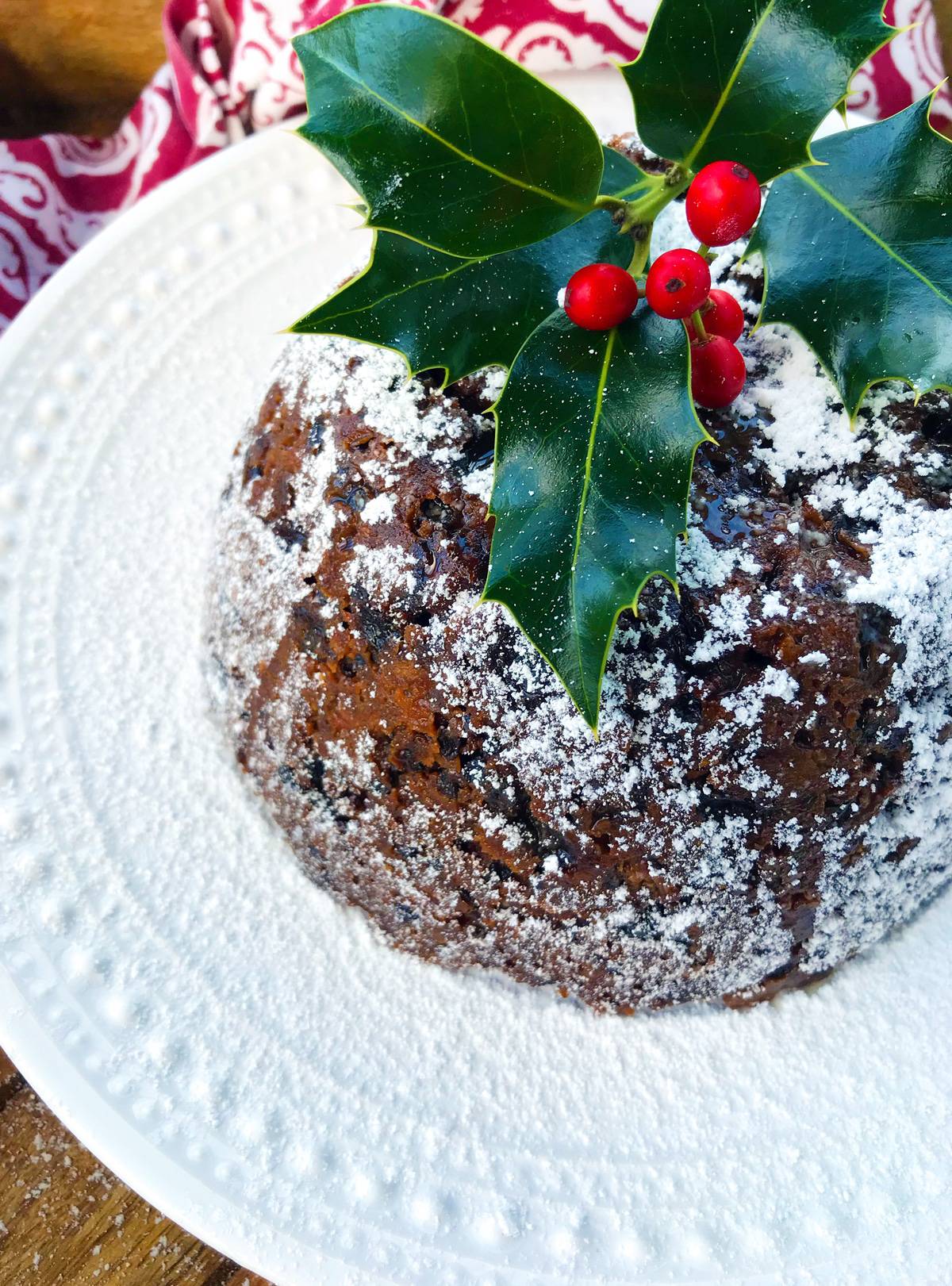
Figgy Pudding Recipe
Let’s get started!
Place the raisins, sultanas, currants, almonds, and candied citrus peel in a bowl. Pour the brandy over and stir to combine the mixture. Cover and let sit overnight to allow the brandy to fully penetrate the fruit.
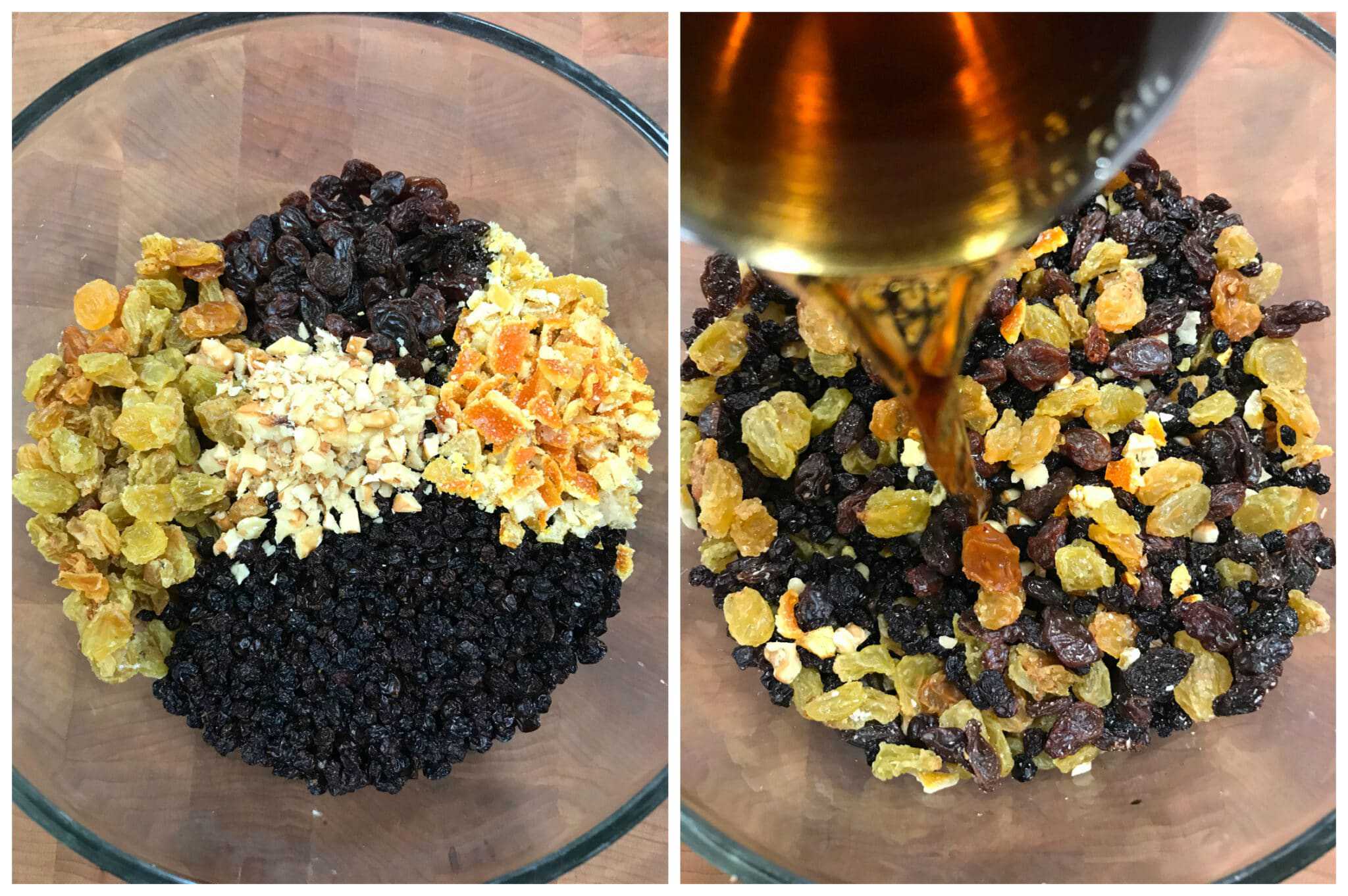
The next day, place the breadcrumbs, flour, brown sugar, baking powder, salt, and spices in a bowl and stir to combine.
In another bowl add the soaked dried fruit mixture, grated apple, suet, lemon and orange zest, black treacle, and egg. Stir to combine.
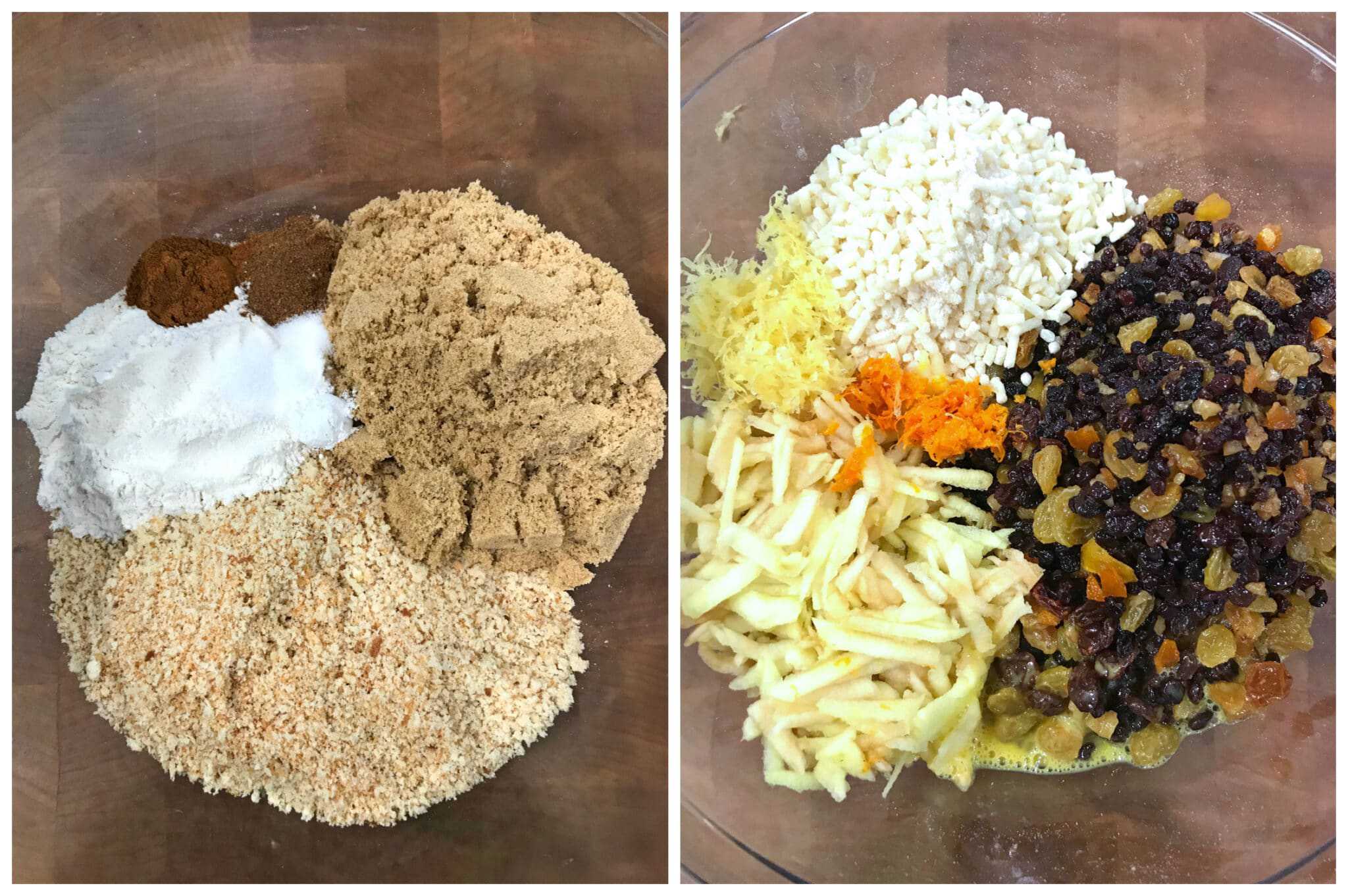
Add the dry mixture to the fruit mixture and stir to thoroughly combine it. It will be thick and sticky.
Generously butter your 2 liter pudding mold and scoop the batter into the mold, pressing down and smoothing the top.
Cut a circle out of parchment paper the same diameter as the top of the pudding mold. Lightly butter the paper and place it, butter side down, on top of the batter. Next tear off two more pieces of parchment paper large enough to cover the to of the pudding mold and partially down the sides of the mold. If your pudding mold is small and the batter comes to the top of it, fold a pleat in the center of the parchment papers to allow room for expansion as the pudding cooks. Trim off excess paper.
Secure the paper by folding down the sides and tying securely with a string (to make it easier you can secure it first with a rubber band while you’re tying it and then remove the rubber band).
Note: If your mold comes with a lid as mine does, I still like to add a layer of parchment paper before securing the lid.
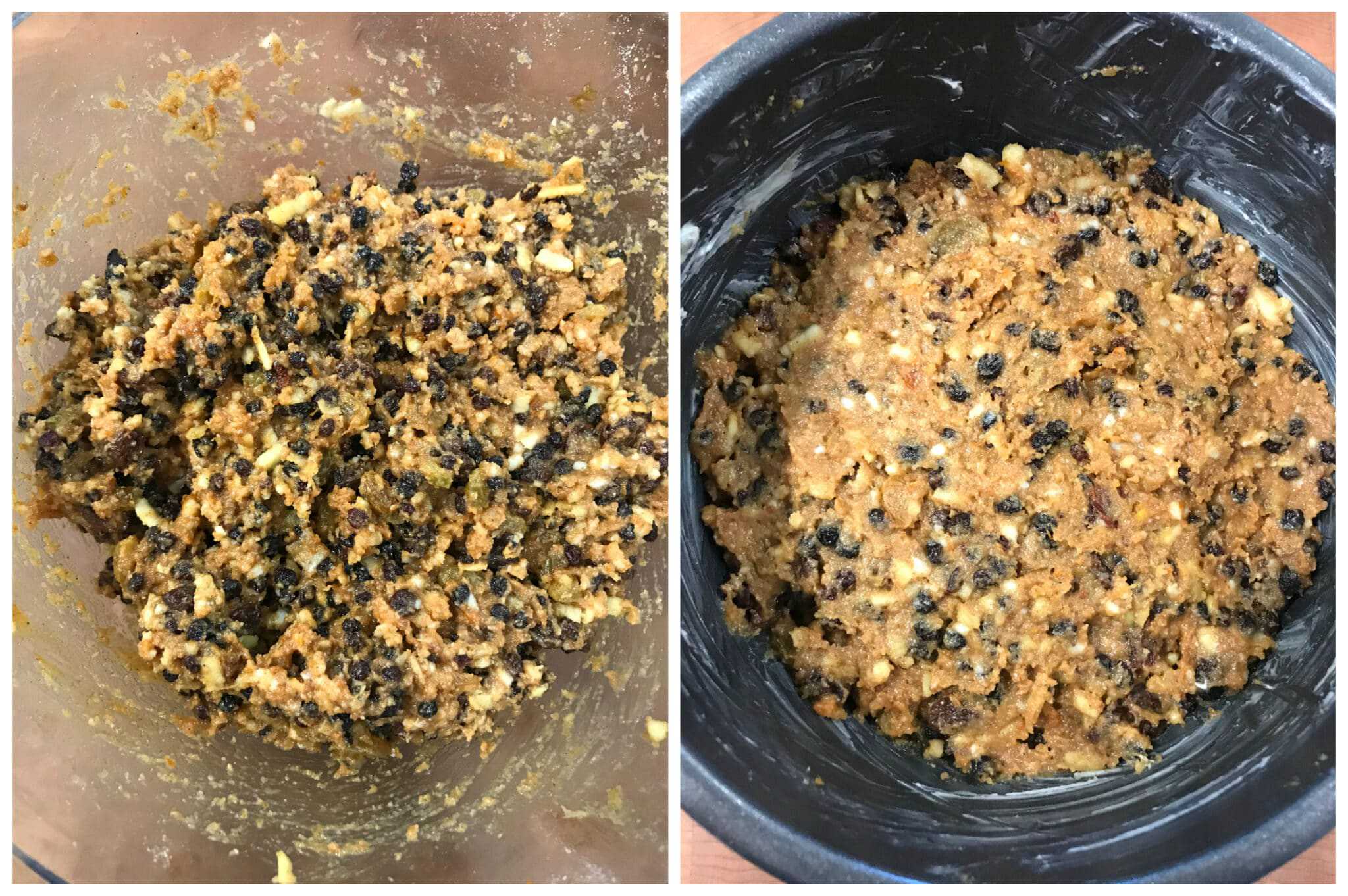
Bring a large pot of water to a very low simmer. Place a folded cloth on the bottom of the pot to prevent the pudding mold from coming in direct contact with the pot in order to prevent scorching.
Lower the pudding mold down into the water on top of the folded cloth. The water level should come up to the halfway point of the pudding mold. Cover the pot with the lid.
Steam the pudding over very low heat for approximately 8 hours. Check periodically to ensure the water level is still at the halfway point and add more water as needed.
The longer the pudding steams the darker in color it will become.
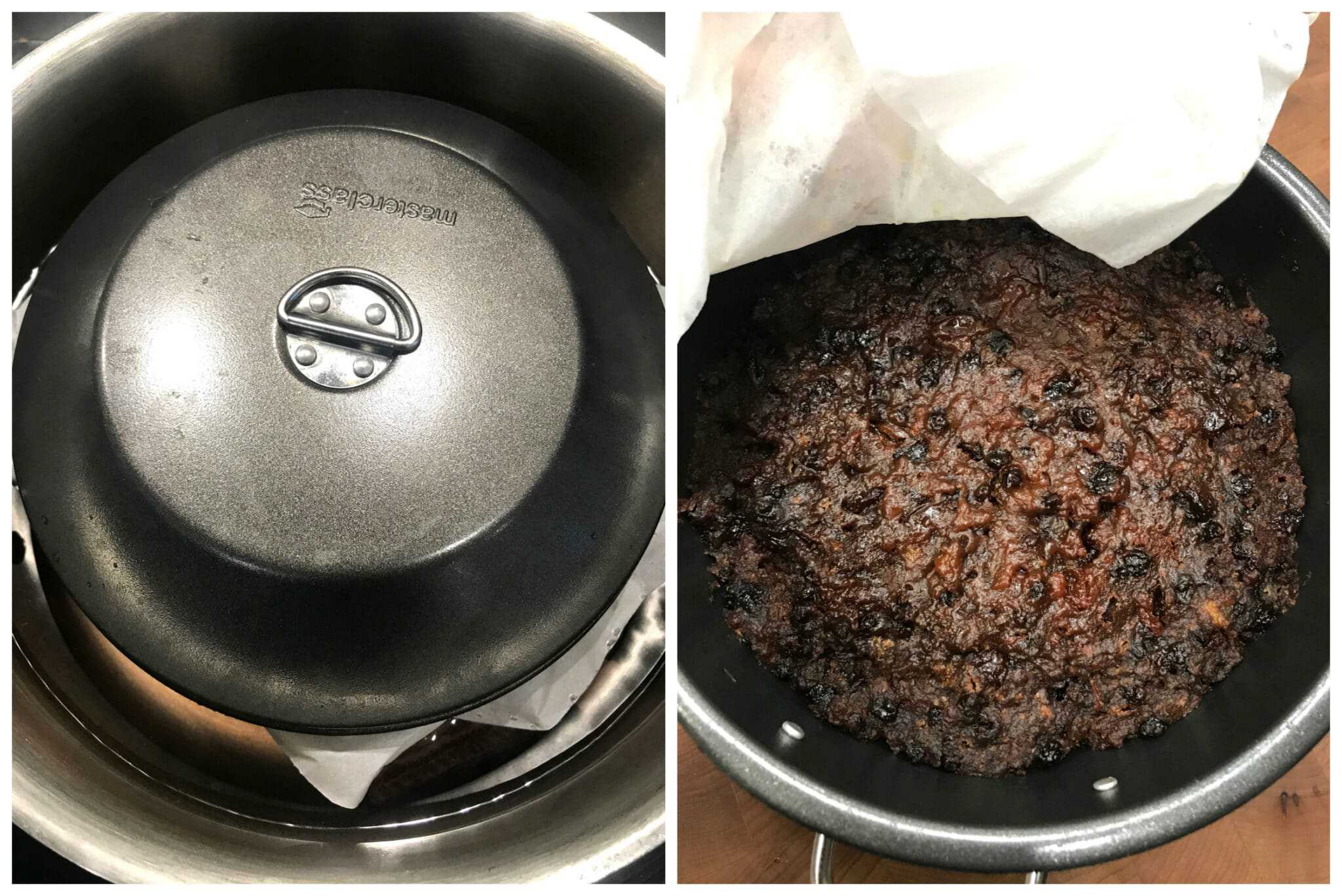
When the pudding is done steaming, carefully lift out the pudding mold and let it sit for 5 minutes. Then invert the pudding on a plate. Let it sit until the pudding slides out onto the plate. Let the pudding cool completely.
To store, if you are freezing it wrap it tightly in at least two layers of plastic wrap, then wrap with foil, and place it in a ziplock freezer bag. remove the parchment paper and wrap the pudding with clean parchment paper followed by aluminum foil. Wrap tightly. Store it in a cool, dark place, preferably a basement. If you don’t have a cool, dark place you can store it in the fridge but first butter the parchment paper before wrapping the pudding to help retain moisture. See storing guidelines section of blog post for more info.
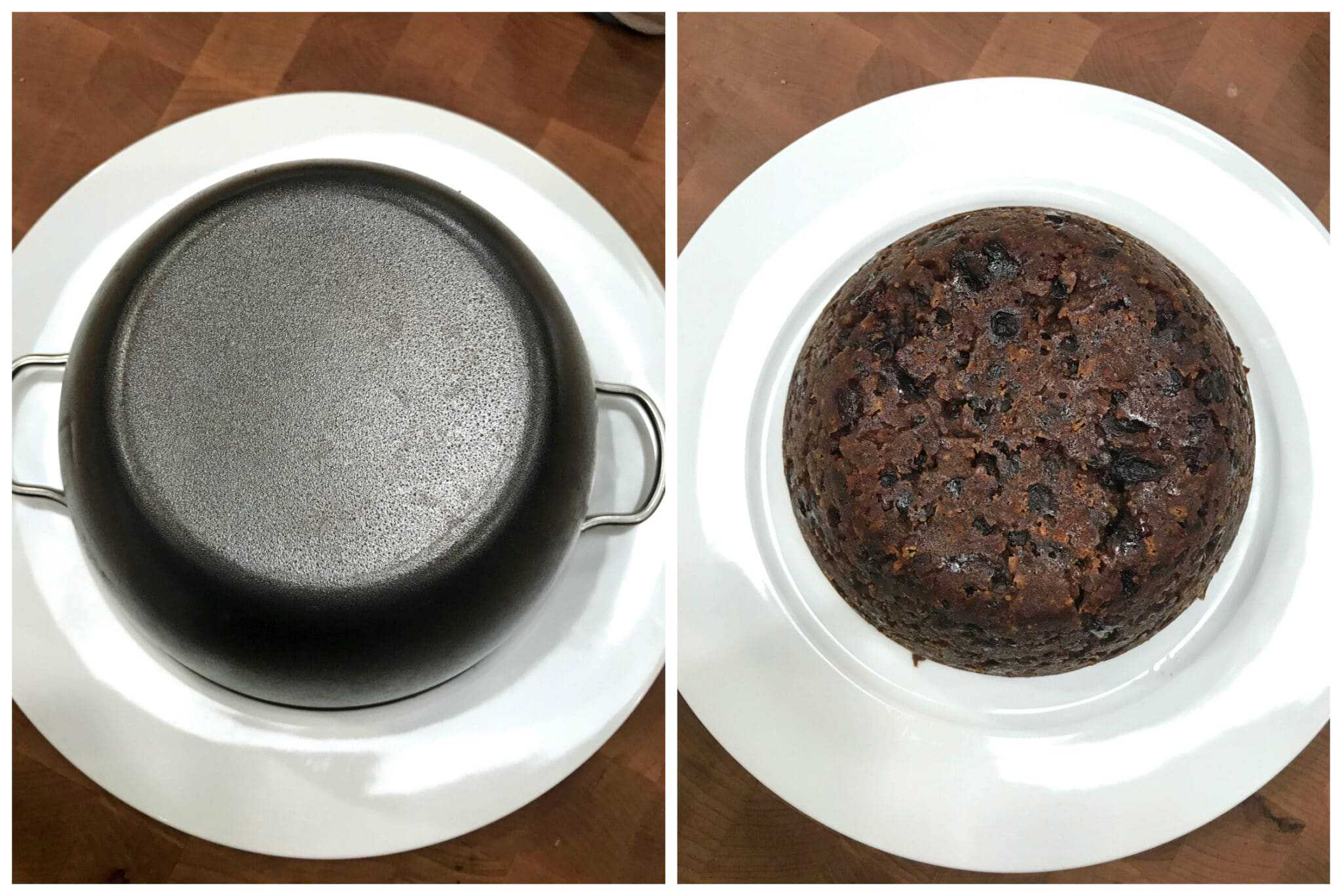
When you’re ready to serve the pudding you will need to reheat it either by re-steaming it for 30-60 minutes or until heated through or you can also microwave it in a microwave safe container to keep the moisture in.
You can light the pudding just before serving (see blog post section on how to light a pudding) and then serve with Hard Sauce, also known as Brandy Butter in the UK. Alternatively you can serve it with a dusting of confectioner’s sugar, some whipped cream, brandy sauce, English custard, ice cream, or lemon sauce.
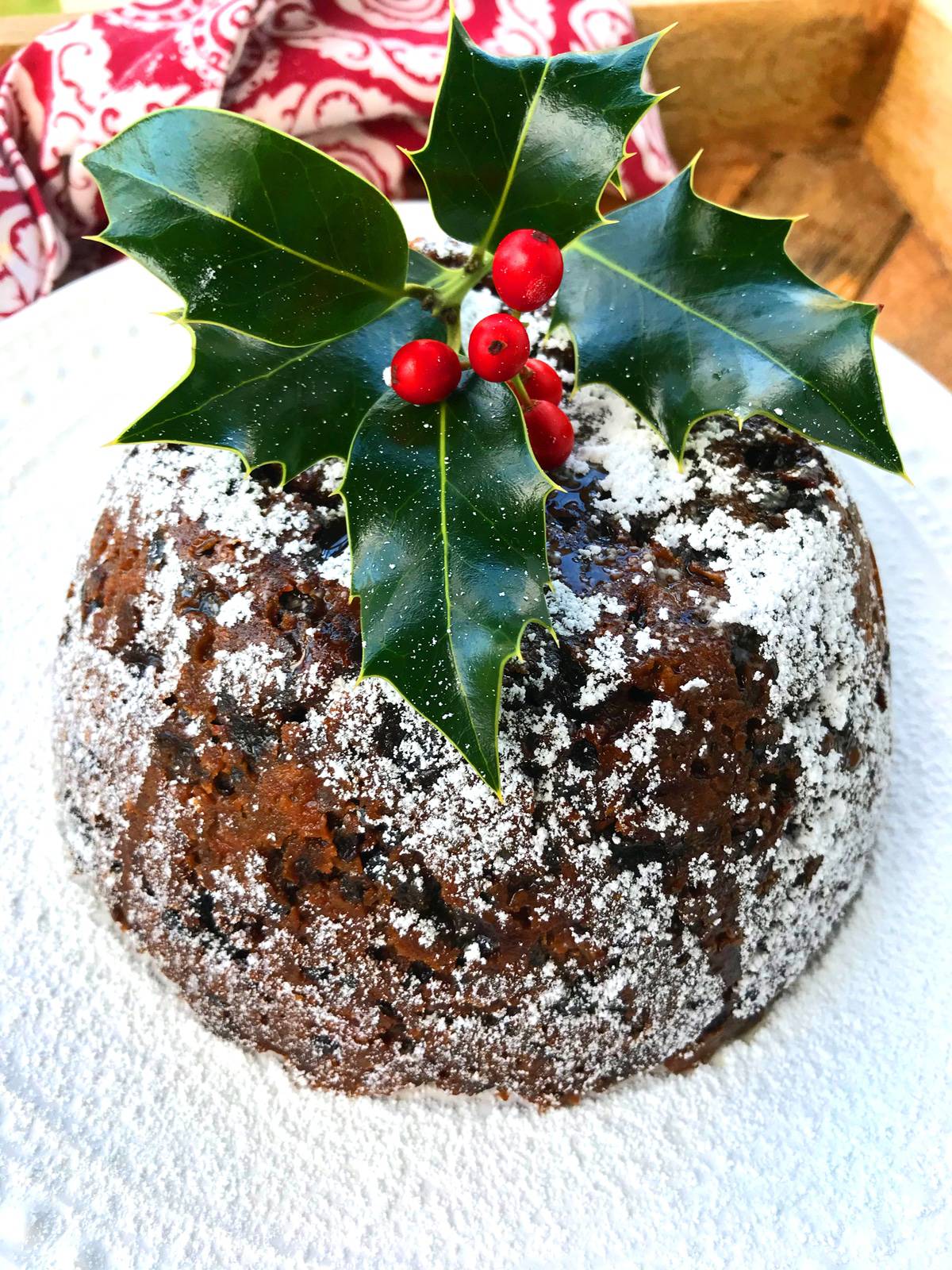
How Far in Advance Should I Make Christmas Pudding?
As with other Christmas goodies that are meant to be made in advance in order to allow their flavors to develop (e.g., Stollen, Lebkuchen, Printen, Springerle, Speculoos, etc), Christmas pudding was traditionally made several weeks before Christmas. The brandy acts as both a preservative and draws out more flavor from the other ingredients. So generally the longer the pudding matures, the more flavorful it will be.
In the UK, Christmas pudding was traditionally prepared on what is known as “Stir-up Sunday” (“stir-up” being a reference from the Book of Common Prayer), the last Sunday before Advent (typically the last Sunday in November, or 5 weeks before Christmas). This was day the pudding ingredients would be assembled and the whole family would be involved “stirring up” the ingredients and then steam the pudding in pudding basins. A popular tradition was to add a silver coin (six pence) to the pudding batter and whoever found the coin in their serving would have good luck. Once cooked and cooled down, the puddings would be carefully wrapped and stored in the basement until ready for serving on Christmas.
How Long Does Figgy Pudding Keep?
Three elements are key to a lengthy storage time: The alcohol and sugar content (preservatives) and proper storage. The pudding needs to be wrapped very tightly and stored in a cool place that is fairly dry but with enough humidity to keep the pudding from drying out. The ideal, and traditional, storage space is a basement or cellar. As long as it is cool but not freezing, a balcony or sheltered area outside out of sunlight will work too. If you do not have a cool, dark environment in your home you can keep it in the fridge but make sure it is tightly wrapped in two layers of plastic wrap and some aluminum foil to prevent it from drying out.
Properly stored, plum pudding will keep for several weeks. (Traditionally it would even be stored for several months, even as long as a year or more, though that makes me a bit nervous.) You can also freeze the pudding for up to a year. Make sure it is well wrapped in two layers of plastic wrap, then aluminum foil, then place it in a freezer bag or airtight container.
How to Reheat and Serve Figgy Pudding
After your pudding is done maturing and you’re ready to serve it, unwrap it, place it back in the pudding mold, cover and re-steam it for 30-60 minutes or until heated through. Alternatively you can cover and microwave the pudding.
The traditional way to serve the pudding is to pour some more brandy over it and set it on fire, letting the fire burn down and then serve it with Hard Sauce, also known as Brandy Butter in the UK. Though hard sauce is traditional you can also serve it with a dusting of confectioner’s sugar, some whipped cream, brandy sauce, English custard, ice cream, or lemon sauce.
How to Light a Christmas Pudding
To set your Christmas pudding on fire pour some brandy, 3-4 tablespoons, into a soup ladle. Hold the ladle over a flame, tipping it slightly to allow the brandy to catch the flame. Once the brandy is on fire, slowly pour the flaming ladle over the top of the pudding; the fire will transfer to the pudding. Wait for the fire to naturally extinguish and then serve the pudding.
Traditionally the pudding is brought to the table, the lights are turned off, and the pudding is set aflame for everyone to see. It’s a guaranteed crowd-pleaser that will elicit “oohs” and “ahhs”!

For more traditional British favorites, be sure to try my:
- Mincemeat
- Mince Pies
- Eccles Cakes
- Sticky Toffee Pudding
- Chelsea Buns
- Hot Cross Buns
- Lardy Cake
- Spotted Dick
- Treacle Tart
- Parkin
Save This Recipe
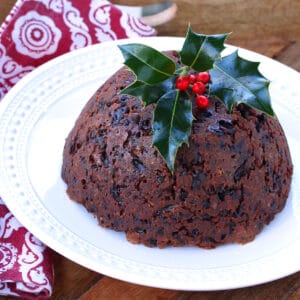
Traditional Figgy Pudding (Christmas Pudding)
Equipment
Ingredients
- 1 cup dried currants (also known as zante raisins)
- 3/4 cup raisins
- 3/4 cup golden raisins/sultanas
- 2 tablespoons finely chopped candied orange peel (click link for recipe, STRONGLY recommend homemade, it makes ALL the difference!)
- 2 tablespoons finely chopped candied lemon peel (click link for recipe, STRONGLY recommend homemade, it makes ALL the difference!)
- 2 tablespoons finely chopped walnuts or almonds , optional
- 1/2 cup brandy (see blog post section about omitting the alcohol)
- 2 cups fresh white breadcrumbs (toast the bread and then pulse in a food processor until you have crumbs)
- 1/2 cup all-purpose flour
- 1/2 teaspoon baking powder
- 1/2 teaspoon salt
- 1 teaspoon mixed spice
- or homemade mixed spice (click link to make your own – I highly recommend it)
- 1 teaspoon ground cinnamon
- 4 ounces shredded beef suet
- 1 cup packed dark brown sugar
- 2 large eggs , lightly beaten
- one small apple , peeled, cored, and grated
- 1 tablespoon black treacle or molasses
- zest of one lemon
- zest of one small orange
- homemade Hard Sauce , for serving (click link for recipe)
Instructions
- Place the raisins, sultanas, currants, almonds, and candied citrus peel in a bowl. Pour the brandy over and stir to combine the mixture. Cover and let sit overnight to allow the brandy to fully penetrate the fruit.
- The next day, place the breadcrumbs, flour, baking powder, brown sugar, and spices in a bowl and stir to combine.In another bowl add the soaked dried fruit mixture, grated apple, black treacle, suet, lemon and orange zest, and egg. Stir to combine.Add the dry mixture to the fruit mixture and stir to thoroughly combine it. It will be thick and sticky.Generously butter your 2 liter/3.5 pint pudding mold and scoop the batter into the mold, pressing down and smoothing the top.
- Cut a circle out of parchment paper the same diameter as the top of the pudding mold. Lightly butter the paper and place it, butter side down, on top of the batter. Next tear off two more pieces of parchment paper large enough to cover the to of the pudding mold and partially down the sides of the mold. If your pudding mold is small and the batter comes to the top of it, fold a pleat in the center of the parchment papers to allow room for expansion as the pudding cooks. Trim off excess paper.Secure the paper by folding down the sides and tying securely with a string (to make it easier you can secure it first with a rubber band while you're tying it and then remove the rubber band).Note: If your mold comes with a lid as mine does, I still like to adda layer of parchment paper before securing the lid.Bring a large pot of water to a very low simmer. Place a folded cloth or trivet on the bottom of the pot to prevent the pudding mold from coming in direct contact with the pot in order to prevent scorching.Lower the pudding mold down into the water on top of the folded cloth. The water level should come up to the halfway point of the pudding mold. Cover the pot with the lid.Steam the pudding over very low heat for approximately 8 hours. The water should not be boiling, it should be steaming. Check periodically to ensure the water level is still at the halfway point and add more water as needed.The longer the pudding steams the darker in color it will become.
- When the pudding is done steaming, carefully lift out the pudding mold and let it sit for 5 minutes. Then invert the pudding on a plate. Let it sit until the pudding slides out onto the plate. Let the pudding cool completely.To store, remove the parchment paper and wrap the pudding with clean parchment paper followed by aluminum foil. Wrap tightly. Store it in a cool, dark place, preferably a basement. If you do not have a cool, dark environment in your home you can keep it in the fridge but make sure it is tightly wrapped in two layers of plastic wrap and some aluminum foil to prevent it from drying out. Follow these same guidelines along with placing the pudding in a ziplock freezer bag to freeze the pudding. When you're ready to serve the pudding you will need to reheat it either by re-steaming it for 30-60 minutes or until heated through or you can also microwave it in a microwave safe container to keep the moisture in.You can light the pudding on fire just before serving (see blog post section on how to light a pudding) and then serve with Hard Sauce (i.e., brandy butter) or powdered sugar, whipped cream, English Custard, ice cream, or lemon sauce.
Nutrition
Originally published on The Daring Gourmet December 15, 2020



















We made this for the first time this year and couldn’t be happier with the results. I even made the homemade candied citrus peels and I agree that it makes a massive difference in the flavor. This will become a Christmas regular. Thank you for this wonderful recipe.
I’m so glad, Candace, thank you very much!
Made it 6 weeks ago and ate it Christmas Day.
I steamed it for ten hours, and then sealed it after cooling with half a cup of brandy. I used a vacuum sealer.
Christmas afternoon I put the vacuum pack in a sous vide at 192 F for two hours.
Let it sit then opened the bag. Served with toffee
This was an easy prep as I imagine steaming it again would be finicky. The recipe was a bit unclear on how to do this.
Flavour slightly too heavy on the treacle but otherwise well received.
Thank you so much for the feedback, Mark, I’m happy your guests enjoyed it!
Phenomenal! Thank you for inspiring a new annual tradition.
Thank you so much, Caroline!
Hello
I have 2 questions, can I use a prepared suet mix in this recipe? (Tandaco brand) or does it need to be a fresh suet from the butcher? Ive never used it before or even knew what it was until finding this recipe.
I also only have a 1 litre pudding mould, can I cook it in 2 batches? Would the time be halved?
Thank you from Oz!
Hi Rachel, yes you can use that suet mix. You can halve it and yes, half the steaming time will probably be adequate. Merry Christmas!
This was a major hit the last two years and we’ll be having it again for Christmas this year. I just wanted to thank you for this superb recipe and so many others that you generously share.
I’m so glad, thank you very much Robbie!
I can’t find suet any where and won’t come through Amazon until January! what can I use to substitute. please and thankyou
Hi Taylor, the texture won’t be quite the same but you can use the same amount of butter. If you look up local butchers they virtually always have suet (not the butcher in the grocery store, but actual independent butcher shops).
I would love to try this, but am wondering if I can make it vegetarian by substituting butter for the suet. If so, can you advise how to do so?
I make some of your other recipes and they are wonderful
Thank you so much! Yes, you can use 4 ounces of butter instead – melt it first. Happy steaming! :)
Made this several times at my husband’s request. it is wonderful, and made me realize how much I like fig pudding. I haven’t had it in a very long time.
Oh thank you so much, Sherri, I’m happy you both enjoyed it and that this has become a regular! <3
How do I get to the “Blog post” regarding storage and shipping
Third year making it
The family loves it and a lot of fun to make
Thanks
If we are not using alcohol in the recipe what do we soak the fruit in the night before?
Thanks.
You can use apple or orange juice or even just water. But the juice will give it more flavor.
This is my second year making this. We enjoyed it so much last year that we’ve decided it has to be a regular tradition. I made the candied peels today in preparation for making the figgy pudding tomorrow to allow the flavors to develop in time for Christmas Eve. This recipe is a keeper and I agree that the homemade candied peels are a must. Thank you for introducing us to this newfound and delicious family tradition!
That’s so wonderful, Marie! I’m thrilled that this has become a tradition in your home and I appreciate the feedback! <3
When you are storing the pudding after 1st steaming, do you wrap tightly and put back in the mold for storage?
Hi Lisa, it will hold its shape so there is no need to put it back in the mold.
Found the link for the hard sauce but not the links for the candied orange and candied lemon peels or the homemade spice mix. Seems to me when I first bookmarked this page they were there but I can’t find them now. Where should I be looking for them? Thanks.
Hi Steve, you’re absolutely right, the links somehow went missing. I’m so glad you brought that to my attention, I’ve just added those links again and they’re there now – thank you!